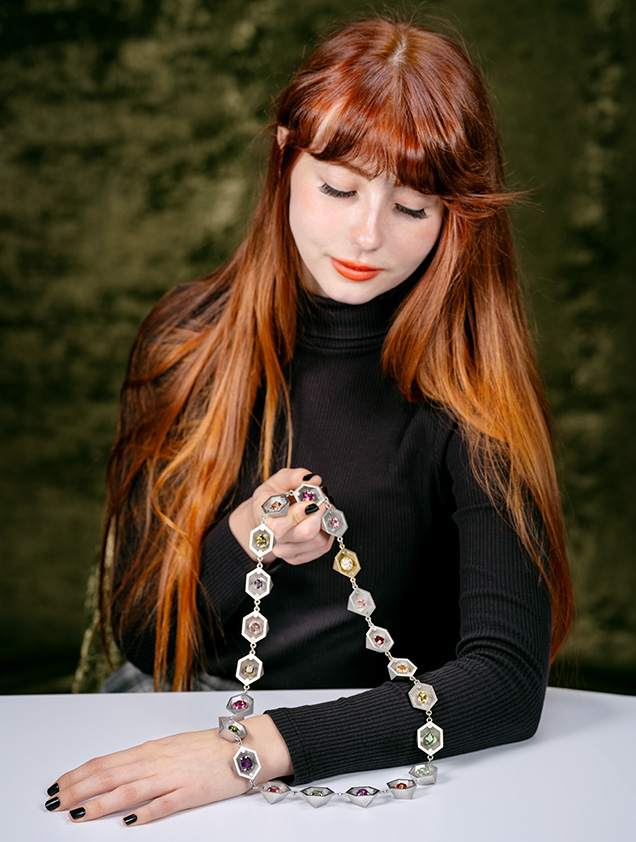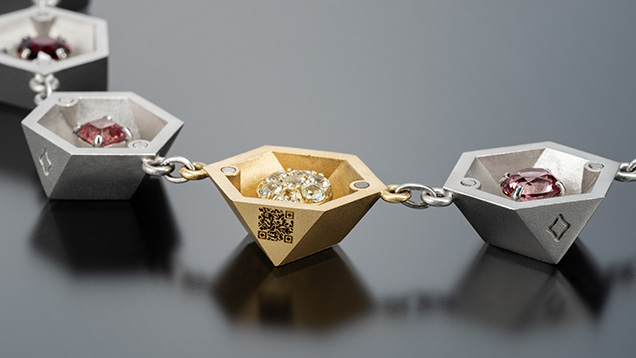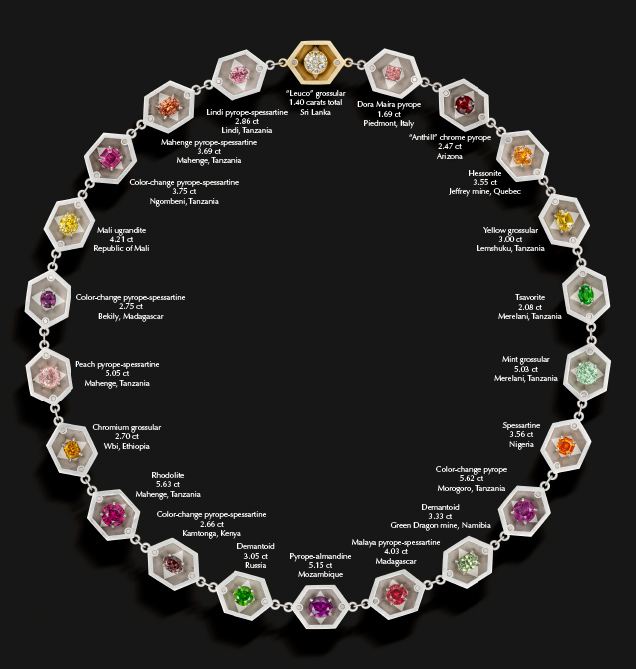Beyond Beauty: A Garnet Necklace Decoded

Two 2023 AGTA Spectrum Awards—Best Use of Platinum and Color and Best Use of Platinum and Color Men’s Wear—were recently awarded to “Garanatus: From Rough to Cut,” a 29-inch platinum necklace set with more than 77 total carats of rare garnets. “Garanatus” is a play on the origin of garnet’s name—granatus, Latin for “seed-like,” because of its resemblance to pomegranate seeds. The necklace was designed and fabricated by Mary van der Aa (Mary van der Aa Fine Jewels, Detroit) using 28 garnets that gem cutter Todd Wacks (Tucson Todd’s Gems, Arizona) collected and hand-faceted over a span of 13 years; van der Aa collaborates with Wacks (figure 1) on all of her jewelry. These are her fourth and fifth Spectrum awards.


The necklace design (figure 2) symbolizes the transformation from rough to faceted garnet. “Garanatus” actually consists of two necklaces that connect with tiny neodymium magnets to form 22 rhombic dodecahedrons—the shape of a rough garnet crystal. Each of these magnetic links encases a garnet (figure 3), and detaching the two pieces reveals the gems inside. The garnet’s type and locality are imprinted on the back of each link. A QR code on the necklace leads to a website detailing the stones and the necklace’s creation.
“We wanted the necklace to be educational because many people don’t know what an incredible stone garnet is,” van der Aa said. “Everyone’s seen every color of sapphire and tourmaline. Garnet doesn’t get the attention it deserves. It can come in any color, even colorless or color change.”

The necklace’s garnet varieties span the color spectrum and localities (figure 4). Perhaps the most impressive is a 1.69 ct pink garnet from the Dora Maira locality in Italy, one of the largest of its type. Five of the garnets show color change. Other highlights include a 5.15 ct “grape jelly” pyrope-almandine from Mozambique; a 3.00 ct yellow grossular of a type reportedly produced by only one deposit in Tanzania in the 1980s; a 2.47 ct red “anthill” garnet that is exceptionally large for its Arizona locale; a 2.70 ct chromium grossular from Ethiopia; and a 2.86 ct Lindi garnet from Tanzania that reacts to UV light. The final addition was a 3.05 ct Russian demantoid with a horsetail inclusion, acquired in 2023, that van der Aa considered necessary to complete the collection.
Wacks acquired the first stone, a 2.75 ct blue color-change garnet from Bekily, Madagascar, while he was a student at GIA (van der Aa is also a GIA graduate). These are even rarer than alexandrite and are easily mistaken for them. “My love for garnet started there,” he said. “After the fifth stone, I realized it was a decent little rainbow.” His search focused on high clarity, color, and dispersion more than size (the sizes range from under a carat to 5.63 ct). “We used the rarest garnets I’ve been able to find,” he said. “Every time I found a strange deposit or an exceptional example of the known localities, I added it to my collection. I don’t know how many thousands of stones I saw.”
“Nine out of ten of them, if I wasn’t a gemologist, I would never guess it was a garnet,” van der Aa said. “Especially because of the sparkle. A lot of them look almost like green diamonds or yellow sapphires.” Wacks added, “There are a few secrets used for cutting these garnets to produce really nice dispersive stones.”
The idea for the necklace came to Wacks in 2020, when he realized the garnets would “really rock” in a necklace and asked van der Aa to design one. She told him it would take some time to develop something amazing. More than 450 hours went into crafting the piece. “It was quite a challenge technically,” she said, noting the uniqueness of the magnetic jacket design and the QR code.
“Garanatus” contains 2.5 lbs (more than 1 kg) of platinum. “These were the best of the best garnets he could find, so I thought platinum was what they deserved,” van der Aa said. The half of the link that features the QR code is 18K gold because the highly reflective platinum didn’t display the QR code well. “The 18K gives a luxe two-tone look,” she said. The 18K gold portion also indicates the back of the necklace and contains a cluster of seven colorless (“leuco”) garnets from Sri Lanka (1.40 carats total) rather than one stone.
Based on GIA researchers’ analysis, these garnets demonstrate the entire range of garnet chemistry in the natural world. Their chemical compositions also shed light on their color origins. Many have color caused by essential chemical components, such as iron in the Namibian demantoid and the purple pyrope-almandine from Mozambique. Some are colored by trace impurity elements, including vanadium in the color-change garnets from East Africa and chromium in the Russian demantoid and the “anthill” garnet.
“You get really sentimental holding on to something like this,” Wacks said. Initially he planned to keep the necklace, but as it neared completion, van der Aa suggested he consider parting with the garnets because it had become so extraordinary.
“To go from saying, ‘Just make a necklace,’ to this—it turned out beyond anything I could have ever thought of,” he said. “It’s likely the most impressive necklace in history displaying the beauty of the garnet group. I’ve done a fair amount of research but haven’t found anything that compares.”
“Our dream is for it to go somewhere people could learn from it and see it and leave with a huge smile, knowing that garnet is such an incredible gemstone,” van der Aa said. “Now he’s okay with parting with them.”
“Garanatus” will be on display in the GIA Museum beginning this spring.



